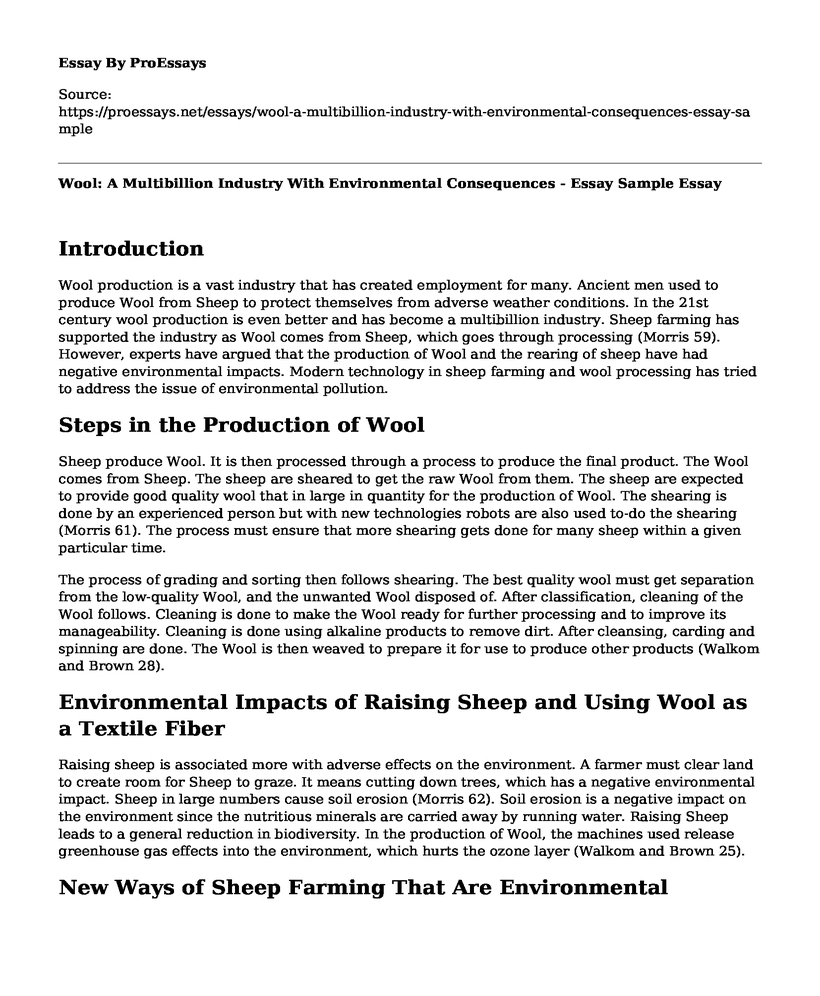Introduction
Wool production is a vast industry that has created employment for many. Ancient men used to produce Wool from Sheep to protect themselves from adverse weather conditions. In the 21st century wool production is even better and has become a multibillion industry. Sheep farming has supported the industry as Wool comes from Sheep, which goes through processing (Morris 59). However, experts have argued that the production of Wool and the rearing of sheep have had negative environmental impacts. Modern technology in sheep farming and wool processing has tried to address the issue of environmental pollution.
Steps in the Production of Wool
Sheep produce Wool. It is then processed through a process to produce the final product. The Wool comes from Sheep. The sheep are sheared to get the raw Wool from them. The sheep are expected to provide good quality wool that in large in quantity for the production of Wool. The shearing is done by an experienced person but with new technologies robots are also used to-do the shearing (Morris 61). The process must ensure that more shearing gets done for many sheep within a given particular time.
The process of grading and sorting then follows shearing. The best quality wool must get separation from the low-quality Wool, and the unwanted Wool disposed of. After classification, cleaning of the Wool follows. Cleaning is done to make the Wool ready for further processing and to improve its manageability. Cleaning is done using alkaline products to remove dirt. After cleansing, carding and spinning are done. The Wool is then weaved to prepare it for use to produce other products (Walkom and Brown 28).
Environmental Impacts of Raising Sheep and Using Wool as a Textile Fiber
Raising sheep is associated more with adverse effects on the environment. A farmer must clear land to create room for Sheep to graze. It means cutting down trees, which has a negative environmental impact. Sheep in large numbers cause soil erosion (Morris 62). Soil erosion is a negative impact on the environment since the nutritious minerals are carried away by running water. Raising Sheep leads to a general reduction in biodiversity. In the production of Wool, the machines used release greenhouse gas effects into the environment, which hurts the ozone layer (Walkom and Brown 25).
New Ways of Sheep Farming That Are Environmental Friendly
Changes in the trait selection of Sheep can help in the reduction of greenhouse gas emitted by Sheep. The modern genetic breed of Sheep can be carefully selected to give animals that release less carbon gas. The processing of Wool should adopt advanced technology that uses less energy. He energy used should be from a renewable source of energy, such as the solar system. It has a less negative impact on the environment compared to the traditional processing methods (Walkom and Brown 21). Maximization of space through the use of small paddocks and zero grazings can help reduce the amount of soil erosion caused by sheep farming or reduce the number of trees cut down to create space for sheep farming(Walkom and Brown 21).
Conclusion
Sheep farming is profitable. Sheep farming should be adopted by all who wish to engage in agriculture. It is a capital intensive investment but comes with satisfaction. Sheep farming gives you a pleasant feeling of grazing in the afternoon. However, the new technology in sheep farming and wool production should be adopted to reduce the negative impact it has on the environment.
Works Cited
Morris, S. T. "Economics of sheep production." Small ruminant research 86.1-3 (2009): 59-62.
Walkom, S. F., and D. J. Brown. "Genetic evaluation of adult ewe bodyweight and condition: relationship with lamb growth, reproduction, carcass, and wool production." Animal Production Science 57.1 (2017): 20-32.
Cite this page
Wool: A Multibillion Industry With Environmental Consequences - Essay Sample. (2023, Mar 20). Retrieved from https://proessays.net/essays/wool-a-multibillion-industry-with-environmental-consequences-essay-sample
If you are the original author of this essay and no longer wish to have it published on the ProEssays website, please click below to request its removal:
- Essay Sample on Employee Training
- Teachers Pay Essay Example
- Difficult Conversations: Resolving Conflicts & Harassment in the Workplace - Essay Sample
- Paper Example on Globalization: Idealistic Motives for Making the World a Single Market Place
- 2007-2009 Recession: Impact on Airline Industry - Research Paper
- Essay Example on Increase in Chronic Diseases: Employer Wellness Programs to the Rescue
- Nike's HRM: Adapting to Globalization for Global Success - Free Paper Example







